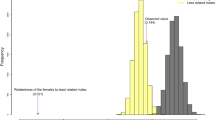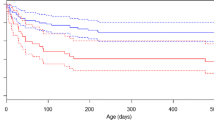Abstract
In most cooperatively breeding species, reproduction is monopolised by a subset of group members. However, in some species most or all individuals breed. The factors that affect reproductive success in such species are vital to understanding why multiple females breed. A key issue is whether or not the presence of other breeders is costly to an individual’s reproductive success. This study examines the factors that affect the post-parturition component of reproductive success in groups of communal-breeding banded mongoose (Mungos mungo), where up to ten females breed together. Per-litter reproductive success was low (only 18% of pups survived from birth to independence). Whilst singular breeding was wholly unsuccessful, there were costs associated with breeding in the presence of increasing numbers of other females and in large groups. Synchronisation of parturition increased litter success, probably because it minimises the opportunity for infanticide or decreases competitive asymmetry between pups born to different females. There was no evidence of inbreeding depression, and reproductive success was generally higher in litters where females only had access to related males within their group. I conclude that communal breeding in female banded mongooses represents a compromise between the benefits of group-living and communal pup care on the one hand, and competition between females to maximise their personal reproductive success on the other. Such conflicts are likely to occur in most communal breeding species. Whilst communal breeding systems are generally considered egalitarian, negative effects of co-breeders on individual reproductive success is still an issue.



Similar content being viewed by others
References
ASAB (1991) Guidelines for the use of animals in research. Anim Behav 41:183–186
Bertram BCR (1975) Social factors influencing reproduction in wild lions. J Zool 177:463–482
Brotherton PNM, Clutton-Brock TH, O’Riain MJ, Gaynor D, Sharpe L, Kansky R, McIlrath GM (2001) Offspring food allocation by parents and helpers in a cooperative mammal. Behav Ecol 12:590–599
Brown JL (1987) Helping and communal breeding in birds. Princeton University Press, Princeton, New Jersey
Brown JL, Brown ER (1998) Are inbred offspring less fit? Survival in a natural population of Mexican jays. Behav Ecol 9:60–63
Cant MA (1998) A model for the evolution of reproductive skew without reproductive suppression. Anim Behav 55:163–169
Cant MA (2000) Social control of reproduction in banded mongooses. Anim Behav 59:147–158
Cant MA (2003) Patterns of helping effort in co-operatively breeding banded mongooses (Mungos mungo). J Zool 259:115–121
Cant MA, Johnstone RA (1999) Costly young and reproductive skew in animal societies. Behav Ecol 10:178–184
Cant MA, Otali E, Mwanguhya F (2001) Eviction and dispersal in co-operatively breeding banded mongooses (Mungos mungo). J Zool 254:155–162
Clutton-Brock TH (1988) Reproductive success: studies of individual variation in contrasting breeding systems. Chicago University Press, Chicago
Clutton-Brock TH, Albon SD, Guinness FE (1982) Competition between female relatives in a matrilocal mammal. Nature 300:178–180
Clutton-Brock TH, Brotherton PNM, Smith R, McIlrath GM, Kansky R, Gaynor D, O'Riain MJ, Skinner JD (1998) Infanticide and expulsion of females in a cooperative mammal. Proc R Soc Lond B Biol Sci 265:2291–2295
Clutton-Brock TH, Brotherton PNM, Russell AF, O'Riain MJ, Gaynor D, Kansky R, Griffin A, Manser M, Sharpe L, McIlrath GM, Small T, Moss A, Monfort S (2001a) Cooperation, control, and concession in meerkat groups. Science 291:478–481
Clutton-Brock TH, Russell AF, Sharpe LL, Brotherton PNM, McIlrath GM, White S, Cameron EZ (2001b) Effects of helpers on juvenile development and survival in meerkats. Science 293:2446–2449
Coulson TN, Pemberton JM, Albon SD, Beaumont M, Marshall TC, Slate J, Guinness FE, Clutton-Brock TH (1998) Microsatellites reveal heterosis in red deer. Proc R Soc Lond B Biol Sci 265:489–495
Craig JL (1980) Breeding success of a common gallinule. Behav Ecol Sociobiol 6:289–295
Creel SR, Waser PM (1997) Variation in reproductive suppression among dwarf mongooses: interplay between mechanisms and evolution. In: Solomon NG, French JA (eds) Cooperative breeding in mammals. University Press, Cambridge, pp 150–170
De Luca DW, Ginsberg JR (2001) Dominance, reproduction and survival in banded mongooses: towards an egalitarian social system? Anim Behav 61:17–30
Doolan SP, Macdonald DW (1996) Diet and foraging behaviour of group-living meerkats, Suricata suricatta, in the southern Kalahari. J Zool 239:697–716
Emlen ST (1991) Evolution of cooperative breeding in birds and mammals. In: Krebs JR, Davies NB (eds) Behavioural ecology: an evolutionary approach, 3rd edn. Blackwell Scientific Publications, Oxford, pp 301–337
Faulkes CG, Bennett NC (2001) Family values: group dynamics and social control of reproduction in African mole-rats. Trends Ecol Evol 16:184–190
Gerlach G, Bartmann S (2002) Reproductive skew, costs, and benefits of cooperative breeding in female wood mice (Apodemus sylvaticus). Behav Ecol 13:408–418
Gilchrist JS (2001) Reproduction and pup care in the communal breeding banded mongoose. PhD. Dissertation. University of Cambridge, United Kingdom
Gilchrist JS (2004) Pup escorting in the communal breeding banded mongoose: behavior, benefits, and maintenance. Behav Ecol 15:952–960
Gilchrist JS (2006) Female eviction, abortion, and infanticide in banded mongooses (Mungos mungo): implications for social control of reproduction and synchronized parturition. Behav Ecol 17(4):664–669
Gilchrist JS, Otali E (2002) The effects of refuse-feeding on home-range use, group size, and intergroup encounters in the bounded mongoose. Canadian Journal of Zoology-Revue Canadienne De Zoologie 80:1795–1802
Gilchrist JS, Otali E, Mwanguhya F (2004) Why breed communally? Factors affecting fecundity in a communal breeding mammal: the banded mongoose (Mungos mungo). Behav Ecol Sociobiol 57:119–131
Hamilton WD (1964) The genetical evolution of social behaviour. J Theor Biol 7:1–52
Hiscocks K, Perrin MR (1991) A dietary comparison between two sympatric viverrids, Helogale parvula (Sundevall 1846) and Mungos mungo (Gmelin 1788). J Afr Zool 105:307–312
Ims R (1990) The ecology and evolution of reproductive synchrony. Trends Ecol Evol 5:135–140
Jamieson IG (1997) Testing reproductive skew models in a communally breeding bird, the pukeko, Porphyrio porphyrio. Proc R Soc Lond B Biol Sci 264:335–340
Jimenez JA, Hughes KA, Alaks G, Graham L, Lacy RC (1994) An experimental study of inbreeding depression in a natural habitat. Science 266:271–273
Johnstone RA, Cant MA (1999) Reproductive skew and the threat of eviction: a new perspective. Proc R Soc Lond B 266:275–279
Keane B, Creel SR, Waser PM (1996) No evidence of inbreeding avoidance or inbreeding depression in a social carnivore. Behav Ecol 7:480–489
Keller L, Reeve HK (1994) Partitioning of reproduction in animal societies. Trends Ecol Evol 9:98–103
Keller LF (1998) Inbreeding and its fitness effects in an insular population of song sparrows (Melospiza melodia). Evolution 52:240–250
Koenig WD, Mumme RL, Stanback MT, Pitelka FA (1995) Patterns and consequences of egg destruction among joint-nesting acorn woodpeckers. Anim Behav 50:607–621
Koford RR, Bowen BS, Vehrencamp SL (1990) Groove-billed anis: joint-nesting in a tropical cuckoo. In: Stacey PB, Koenig WD (eds) Cooperative breeding in birds: long-term studies of ecology and behaviour. Cambridge University Press, Cambridge, pp 333–356
Lewis SE, Pusey AE (1997) Factors influencing the occurrence of communal care in plural breeding mammals. In: Solomon NG, French JA (eds) Cooperative breeding in mammals. University Press, Cambridge, pp 335–363
Lock JM (1977) The vegetation of Rwenzori National Park, Uganda. Botanische Jahrbücher für Systematik, Pflanzengeschichte und Pflanzengeographie 98:372–448
Manning CJ, Dewsbury DA, Wakeland EK, Potts WK (1995) Communal nesting and communal nursing in house mice (Mus musculus domesticus). Anim Behav 50:741–751
Marin G, Pilastro A (1994) Communally breeding dormice, glis-glis, are close kin. Anim Behav 47:1485–1487
Mennella JA, Blumberg MS, McClintock MK, Moltz H (1990) Interlitter competition and communal nursing among Norway rats—advantages of birth synchrony. Behav Ecol Sociobiol 27:183–190
Neal E (1970) The banded mongoose, Mungos mungo Gmelin. East Afr Wildl J 8:63–71
Otali E, Gilchrist JS (2004) Effects of refuse feeding on body condition, reproduction and survival of banded mongooses. J Mammal 85:491–497
Packer C, Pusey AE, Eberly LE (2001) Egalitarianism in female African lions. Science 293:690–693
Reeve HK, Westneat DF, Noon WA, Sherman PW, Aquadro CF (1990) DNA Fingerprinting reveals high-levels of inbreeding in colonies of the eusocial naked mole-rat. Proc Natl Acad Sci USA 87:2496–2500
Reeve HK, Emlen ST, Keller L (1998) Reproductive sharing in animal societies: reproductive incentives or incomplete control by dominant breeders? Behav Ecol 9:267–278
Rood JP (1974) Banded mongoose males guard young. Nature 248:176–177
Rood JP (1975) Population dynamics and food habitats of the banded mongoose. East Afr Wildl J 13:89–111
Slate J, Kruuk LEB, Marshall TC, Pemberton JM, Clutton-Brock TH (2000) Inbreeding depression influences lifetime breeding success in a wild population of red deer (Cervus elaphus). Proc R Soc Lond B Biol Sci 267:1657–1662
Sokal RR, Rohlf FJ (1995) Biometry: the principles and practice of statistics in biological research, 3rd edn. W. H. Freeman, New York
Vehrencamp SL (1983) A model for the evolution of despotic versus egalitarian societies. Anim Behav 31:667–682
Vehrencamp SL, Koford RR, Bowen BS (1988) The effect of breeding-unit size on fitness components in groove-billed anis. In: Clutton-Brock TH (ed) Reproductive success: studies of individual variation in contrasting breeding systems. University of Chicago Press, Chicago, pp 291–304
Waser PM, Elliott LF, Creel NM, Creel SR (1995) Habitat variation and mongoose demography. In: Sinclair ARE, Arcese P (eds) Serengeti II: dynamics, management and conservation of an ecosystem. University Press, Chicago, pp 421–448
Wolff JO (1994) Reproductive success of solitarily and communally nesting white-footed mice and deer mice. Behav Ecol 5:206–209
Acknowledgements
I thank Emily Otali and Francis Mwanguhya for their invaluable assistance with data collection, Tim Clutton-Brock and Tim Coulson for advice, and Andy Russell, Mike Cant, Giacomo Tavecchia and the reviewers for comments on the manuscript. I am grateful to the Uganda Wildlife Authority for allowing me to conduct this research in Queen Elizabeth National Park. For financial support, I thank the Biotechnology and Biological Sciences Research Council, the Ian Karten Charitable Trust, and in Cambridge: Magdalene College, the Board of Graduate Studies, the Cambridge Philosophical Society, and the Department of Zoology.
Author information
Authors and Affiliations
Corresponding author
Additional information
Communicated by E. Korpimäki
Rights and permissions
About this article
Cite this article
Gilchrist, J.S. Reproductive success in a low skew, communal breeding mammal: the banded mongoose, Mungos mungo . Behav Ecol Sociobiol 60, 854–863 (2006). https://doi.org/10.1007/s00265-006-0229-6
Received:
Revised:
Accepted:
Published:
Issue Date:
DOI: https://doi.org/10.1007/s00265-006-0229-6




